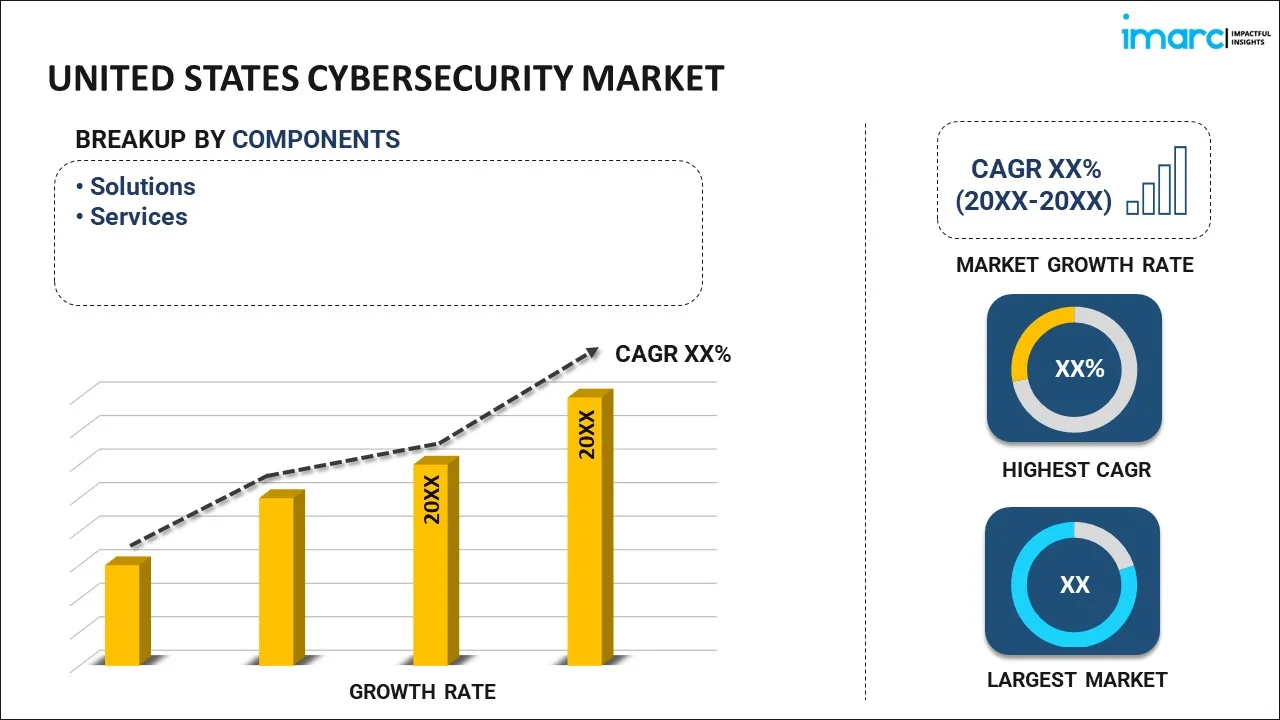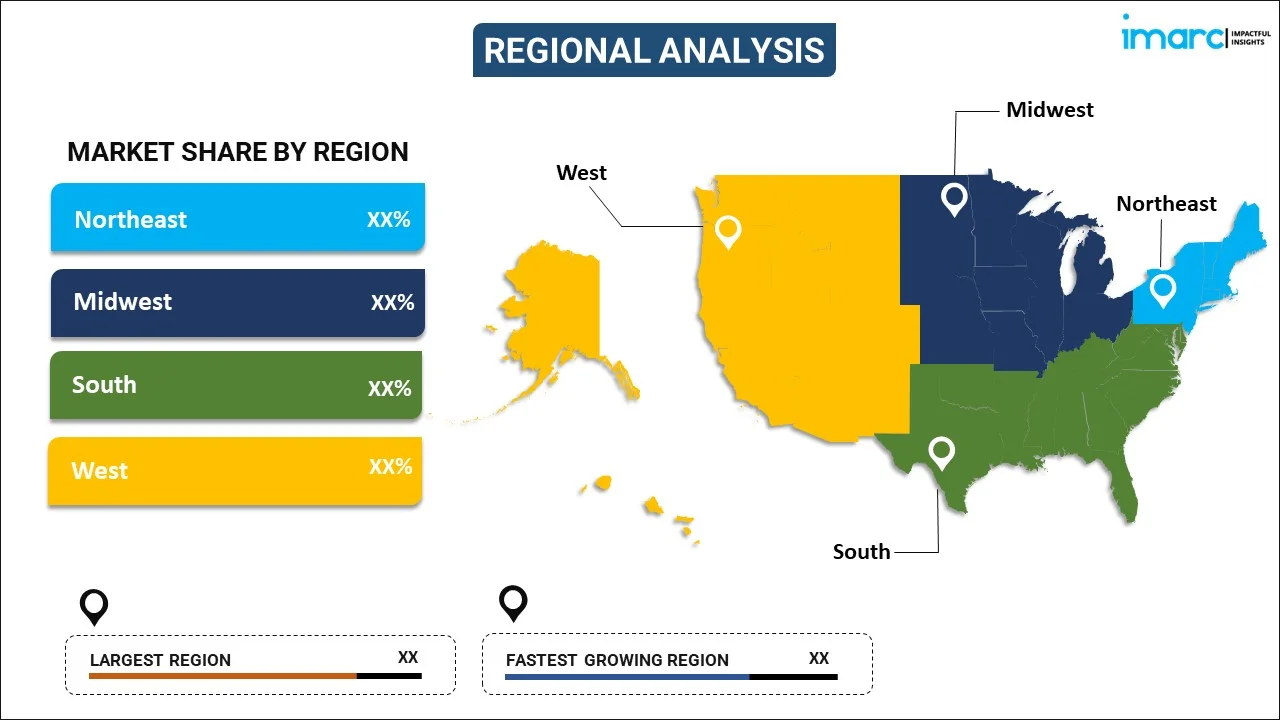
United States Cybersecurity Market Report by Component (Solutions, Services), Deployment Type (Cloud Based, On-Premises), User Type (Large Enterprises, Small and Medium Enterprises), Industry Vertical (IT and Telecom, Retail, BFSI, Healthcare, Defense/Government, Manufacturing, Energy, and Others), and Region 2025-2033
Market Overview:
The United States cybersecurity market size reached USD 84.9 Billion in 2024. Looking forward, IMARC Group expects the market to reach USD 167.9 Billion by 2033, exhibiting a growth rate (CAGR) of 7.9% during 2025-2033. The increasing cyber threats, ongoing digital transformation, strict data protection and privacy regulations, technological advancements, the growing cyber insurance market, and the increasing remote workforce represent some of the key factors driving the United States cybersecurity market share.
|
Report Attribute
|
Key Statistics
|
|---|---|
|
Base Year
|
2024 |
|
Forecast Years
|
2025-2033 |
|
Historical Years
|
2019-2024
|
| Market Size in 2024 | USD 84.9 Billion |
| Market Forecast in 2033 | USD 167.9 Billion |
| Market Growth Rate (2025-2033) | 7.9% |
United States Cybersecurity Market Analysis:
- Major Drivers: Evolving sophistication of cyberattacks and ransomware threats, rising regulatory compliance demands, growing use of cloud services and remote workforce paradigms, and broadening Internet of Things (IoT) ecosystem vulnerabilities are fueling high investment in advanced cybersecurity solutions across every industry vertical.
- Key Market Trends: AI-driven threat detection and incident response automated systems are becoming increasingly prominent, zero-trust security architectures are becoming mainstream, cybersecurity-as-a-service models are growing exponentially, and enterprises are focusing on proactive threat hunting and vulnerability management to keep ahead of emerging cyber threats.
- Market Challenges: According to the United States cybersecurity market analysis, the ongoing cybersecurity skills shortage, rising sophistication of hybrid IT environments, striking balance between security controls and operational efficiency, cost management of end-to-end security solutions, and keeping up with fast-evolving threat landscape remain key challenges for organizations.
- Market Opportunities: AI and machine learning (ML) integration in security products, growth in managed security services, creation of industry-specific cybersecurity models, increasing privacy-oriented technology demand, and quantum-resistant cryptography emergence offer significant United States cybersecurity market growth.
Cybersecurity protects computer systems, networks, software, and data from digital attacks, unauthorized access, and other malicious activities. Its primary objective is to ensure information and computing resources' confidentiality, integrity, and availability. Cybersecurity encompasses a wide range of measures and strategies to safeguard digital assets from diverse threats, such as cybercrime, hacking, data breaches, ransomware, malware, and phishing. It involves both proactive and reactive approaches, including preventive measures like firewalls, encryption, access controls, and security awareness training for users, as well as incident response plans and recovery strategies to mitigate and address security breaches when they occur. The rapid growth of the Internet of Things (IoT), cloud computing, and mobile devices has expanded the attack surface, making cybersecurity an ongoing and dynamic process. Emphasizing a robust cybersecurity posture is crucial in ensuring the trust and stability of digital infrastructures.
United States Cybersecurity Market Trends:
AI-Powered Cybersecurity Solutions
Artificial intelligence and machine learning technologies are transforming the world of cybersecurity by facilitating real-time proactive threat detection and incident response automation. Organizations are increasingly adopting AI-powered security tools that can scan enormous volumes of data in real-time to detect anomalies, identify probable threats, and respond to security breaches quicker than is feasible through traditional approaches. These solutions utilize behavioral analytics and pattern detection to identify advanced attacks that may evade traditional security controls. The adoption of AI into cybersecurity tools is improving threat intelligence functions, eliminating false alarms, and allowing security teams to target high-priority attacks. ML models constantly evolve to address new attack methods, offering real-time protection against changing cyber threats. This trend is important especially because cyberattacks become increasingly more sophisticated and automated, necessitating similarly sophisticated countermeasures in order to sustain effective security postures.
Zero-Trust Security Architecture Implementation
The zero-trust security framework is increasingly becoming popular with organizations as they realize that the classical perimeter-based security measures are no longer adequate for contemporary dispersed IT environments. This holistic security framework presumes that all users, devices, and network elements cannot be presumed to be trusted and therefore all access requests need to be verified and authenticated on a continuous basis. Zero-trust deployment includes micro-segmentation of the networks, multi-factor authentication, least-privilege access limitations, and real-time monitoring of all network traffic. Companies are spending big on zero-trust models to protect their hybrid cloud environments, remote workforce, and IoT deployments. The model offers fine-grained visibility and control over all network traffic, minimizing the attack surface and restricting lateral movement of threats across organizational networks. With more and more sophisticated cyber threats and increasingly expensive data breaches, zero-trust architecture is a paradigm shift towards more secure and dynamic security measures.
Cybersecurity-as-a-Service Growth
The cybersecurity-as-a-service model is undergoing swift growth as companies want to avail themselves of sophisticated security capabilities without substantial capital outlays or internal expertise demands. The service delivery model includes managed security services, security consulting services, threat intelligence services, and cloud security solutions that offer scalable and economical protection. Small and medium-sized businesses especially gain from this trend because they can avail themselves of enterprise-class security technologies and skills that would otherwise be unaffordable to build on their own. Service providers provide 24/7 monitoring, incident response, compliance management, and threat hunting services that strengthen organizational security postures while simplifying operations. The increased shortage of cybersecurity experts is propelling United States cybersecurity market demand for managed services as companies find it difficult to establish and maintain in-house security teams. This shift allows firms to concentrate on core business while providing strong cybersecurity protection by specialist service providers.
United States Cybersecurity Market Segmentation:
IMARC Group provides an analysis of the key trends in each segment of the United States cybersecurity market report, along with forecasts at the country level for 2025-2033. Our report has categorized the market based on component, deployment type, user type and industry vertical.
Component Insights:

To get more information on this market, Request Sample
- Solutions
- Identity and Access Management (IAM)
- Infrastructure Security
- Governance, Risk and Compliance
- Unified Vulnerability Management Service Offering
- Data Security and Privacy Service Offering
- Others
- Services
- Professional Services
- Managed Services
The report has provided a detailed breakup and analysis of the market based on the component. This includes solutions (identity and access management (IAM), infrastructure security, governance, risk and compliance, unified vulnerability management service offering, data security and privacy service offering, and others) and services (professional services and managed services).
Deployment Type Insights:
- Cloud Based
- On-Premises
A detailed breakup and analysis of the market based on the deployment type has also been provided in the report. This includes cloud based and on-premises.
User Type Insights:
- Large Enterprises
- Small and Medium Enterprises
A detailed breakup and analysis of the market based on the user type has also been provided in the report. This includes large enterprises, and small and medium enterprises.
Industry Vertical Insights:
- IT and Telecom
- Retail
- BFSI
- Healthcare
- Defense/Government
- Manufacturing
- Energy
- Others
A detailed breakup and analysis of the market based on the industry vertical has also been provided in the report. This includes IT and telecom, retail, BFSI, healthcare, defense/government, manufacturing, energy, and others.
Regional Insights:

- Northeast
- Midwest
- South
- West
The report has also provided a comprehensive analysis of all the major regional markets, which include Northeast, Midwest, South, and West.
Competitive Landscape:
The report has also provided a comprehensive analysis of the competitive landscape in the market. Competitive analysis such as market structure, key player positioning, top winning strategies, competitive dashboard, and company evaluation quadrant has been covered in the report. Also, detailed profiles of all major companies have been provided.
Recent News and Development:
- In September 2025, 27 cybersecurity M&A deals were announced, marking a slowdown compared to previous months. Key transactions include Accenture acquiring Australia’s CyberCX for over $650 million, CrowdStrike buying Spain-based Onum for $290 million, and Diginex acquiring Israel’s Findings for $305 million. Other notable deals involve F5 purchasing MantisNet and Incode acquiring AuthenticID, reflecting continued consolidation and technology expansion in cybersecurity services, cloud-native solutions, and AI-driven identity and fraud prevention.
- In July 2025, rising cybercrime is driving a surge in U.S. cybersecurity M&A in 2025, as businesses face escalating threats, regulatory pressures, and financial liabilities. Global cybercrime costs exceeded $16 billion in 2024, with major ransomware and phishing attacks targeting critical infrastructure, utilities, and telecoms. Incidents like the Change Healthcare breach and attacks on AT&T, Verizon, and Lumen highlight sector vulnerabilities, while IoT malware and AI-driven phishing are increasing attack complexity, fueling demand for stronger digital defenses and strategic acquisitions.
United States Cybersecurity Market Report Coverage:
| Report Features | Details |
|---|---|
| Base Year of the Analysis | 2024 |
| Historical Period | 2019-2024 |
| Forecast Period | 2025-2033 |
| Units | Billion USD |
| Scope of the Report | Exploration of Historical and Forecast Trends, Industry Catalysts and Challenges, Segment-Wise Historical and Predictive Market Assessment:
|
| Components Covered |
|
| Deployment Types Covered | Cloud Based, On-Premises |
| User Types Covered | Large Enterprises, Small and Medium Enterprises |
| Industry Verticals Covered | IT and Telecom, Retail, BFSI, Healthcare, Defense/Government, Manufacturing, Energy, Others |
| Regions Covered | Northeast, Midwest, South, West |
| Customization Scope | 10% Free Customization |
| Post-Sale Analyst Support | 10-12 Weeks |
| Delivery Format | PDF and Excel through Email (We can also provide the editable version of the report in PPT/Word format on special request) |
Key Benefits for Stakeholders:
- IMARC’s report offers a comprehensive quantitative analysis of various market segments, historical and current market trends, market forecasts, and dynamics of the United States cybersecurity market from 2019-2033.
- The research study provides the latest information on the market drivers, challenges, and opportunities in the United States cybersecurity market.
- Porter's five forces analysis assist stakeholders in assessing the impact of new entrants, competitive rivalry, supplier power, buyer power, and the threat of substitution. It helps stakeholders to analyze the level of competition within the United States cybersecurity industry and its attractiveness.
- Competitive landscape allows stakeholders to understand their competitive environment and provides an insight into the current positions of key players in the market.
Key Questions Answered in This Report
The cybersecurity market in the United States was valued at USD 84.9 Billion in 2024.
The United States cybersecurity market is projected to exhibit a CAGR of 7.9% during 2025-2033, reaching a value of USD 167.9 Billion by 2033.
The market is driven by increasing cyber threats and sophisticated attacks, ongoing digital transformation across industries, strict regulatory compliance requirements, widespread adoption of cloud services and remote work models, growing Internet of Things ecosystem vulnerabilities, and rising demand for AI-powered security solutions.
Need more help?
- Speak to our experienced analysts for insights on the current market scenarios.
- Include additional segments and countries to customize the report as per your requirement.
- Gain an unparalleled competitive advantage in your domain by understanding how to utilize the report and positively impacting your operations and revenue.
- For further assistance, please connect with our analysts.
 Request Customization
Request Customization
 Speak to an Analyst
Speak to an Analyst
 Request Brochure
Request Brochure
 Inquire Before Buying
Inquire Before Buying




.webp)




.webp)












